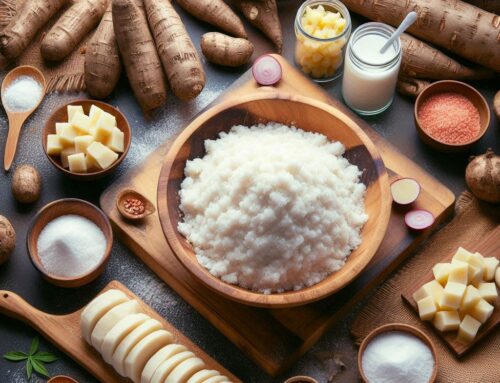
Introduction: Understanding Cassava and Its Importance in Global Diets
Cassava, also known as manioc or yuca, is a root vegetable that plays a crucial role in the diets of millions worldwide. As a staple food in many tropical regions, cassava is particularly valued for its ability to thrive in poor soil conditions and withstand periods of drought. This resilience makes it an essential crop for food security in developing countries.
From a nutritional standpoint, cassava is rich in carbohydrates, providing a significant source of energy. However, it is relatively low in protein and other essential nutrients compared to other staple foods like rice or wheat. Despite this, its versatility and adaptability have cemented its place in global diets.
Cassava uses extend beyond mere sustenance; it serves various culinary purposes across different cultures. In Africa, it’s often ground into flour to make fufu or gari, while Latin American cuisines feature cassava as fried snacks or boiled accompaniments. Additionally, cassava starch—commonly known as tapioca—is used worldwide as a thickening agent in desserts and beverages.
Understanding the role of cassava nutrition and its diverse applications sheds light on why this humble root remains an indispensable component of global diets today.
Myth 1: Cassava is Inherently Toxic to Humans
Cassava, a staple food for millions worldwide, often gets a bad rap due to the myth that it is inherently toxic to humans. This misconception primarily stems from the presence of naturally occurring cyanogenic glycosides in cassava, which can release cyanide when improperly prepared. However, it’s crucial to understand that cassava is not inherently dangerous if handled correctly.
The key lies in safe preparation methods that have been practiced for generations. Techniques such as soaking, boiling, fermenting, and drying significantly reduce the levels of these compounds, rendering cassava safe for consumption. These traditional methods effectively eliminate potential toxins and are widely used in communities where cassava is a dietary cornerstone.
Understanding this myth about cassava toxicity helps dispel unwarranted fears surrounding this versatile crop. By focusing on proper preparation techniques, we can continue to enjoy the nutritional benefits of cassava without concern for its safety.
Myth 2: All Varieties of Cassava are Dangerous to Eat Raw
When it comes to consuming cassava, a common myth is that all varieties are dangerous to eat raw. However, this isn’t entirely accurate. Understanding the differences between sweet and bitter cassava varieties can help clarify this misconception.
Sweet cassava varieties contain lower levels of cyanogenic glycosides, the compounds that can release cyanide when consumed raw. This means they can be safely eaten in their raw state in small quantities. These types of cassavas are often referred to as “edible cassavas” because they pose less risk when prepared correctly.
On the other hand, bitter cassava varieties have higher concentrations of these compounds and require thorough processing—such as soaking, cooking, or fermenting—to ensure they are safe for consumption. This processing helps break down the toxins and makes them suitable for eating.
In summary, while some caution is necessary with certain types of cassava, not all varieties pose an immediate danger if consumed raw. By distinguishing between sweet and bitter types and preparing them appropriately, one can safely enjoy this versatile root vegetable without concern.
Myth 3: Consuming Cassava Leads to Health Issues Only in Developing Countries
When it comes to the topic of cassava and health risks worldwide, a common misconception is that consuming cassava leads to health issues only in developing countries. However, this myth oversimplifies the complex relationship between cassava consumption and health, and fails to consider its nutritional value and global implications.
Cassava is a staple food for millions across the globe, prized for its resilience in harsh climates and its ability to provide sustenance where other crops might fail. Yet, concerns about its safety often arise due to the presence of naturally occurring cyanogenic glycosides in raw cassava, which can release cyanide if not properly prepared. This risk is not confined by geography; it’s a universal concern that requires proper education on preparation methods.
Globally, misconceptions about cassava safety often stem from inadequate knowledge about these preparation techniques rather than inherent dangers of the crop itself. When processed correctly—through peeling, soaking, and cooking—cassava can be consumed safely while offering significant nutritional benefits such as carbohydrates for energy and essential minerals like calcium and phosphorus.
In both developed and developing countries alike, understanding these nuances is crucial. By dispelling myths surrounding cassava consumption through informed discussions about preparation practices and nutritional insights, we can better appreciate this vital crop’s role in global food security without unfounded fears overshadowing its benefits.
Myth 4: Cooking Cannot Eliminate Toxins from Cassava Effectively
Cassava, a staple food for millions worldwide, often comes under scrutiny due to its naturally occurring cyanogenic compounds. A common myth suggests that cooking cannot effectively eliminate these toxins, posing a risk to those who consume it. However, understanding the safest ways to cook cassava is crucial in dispelling this misconception.
To ensure safe consumption, it’s essential to employ cooking techniques that significantly reduce cyanide levels. Boiling is one of the most effective methods; by peeling and chopping cassava into small pieces before boiling, you allow the toxins to leach out into the water. It’s important to discard the water afterward as it contains dissolved cyanide compounds.
Another method involves soaking peeled cassava in water for several hours or overnight before cooking. This process helps break down the cyanogenic glycosides, further reducing potential toxicity when followed by thorough boiling or steaming.
Fermentation is also a traditional technique used in various cultures to enhance safety and flavor. By allowing cassava to ferment naturally over several days, harmful compounds are broken down through microbial action.
In summary, while raw cassava does contain toxic elements, proper preparation and cooking can effectively minimize these risks. By employing methods such as boiling, soaking, or fermentation, you can safely enjoy this versatile root vegetable without concern for its natural toxins.
Myth 5: There Are No Benefits to Including Cassava in Your Diet
Contrary to the myth that cassava offers no benefits, incorporating this root vegetable into your diet can provide numerous nutritional advantages. Cassava is a staple in many diets rich in root vegetables, and for good reason. It is an excellent source of carbohydrates, providing a significant energy boost essential for daily activities. This makes it especially beneficial for individuals with high energy demands.
Moreover, cassava contains essential vitamins and minerals such as vitamin C, folate, and magnesium. Vitamin C acts as an antioxidant that supports the immune system and skin health, while folate is crucial for DNA synthesis and repair—making it particularly important during periods of rapid growth such as pregnancy. Magnesium contributes to muscle function and bone health.
In addition to these nutritional benefits, consuming cassavas can also aid in digestive health due to their high fiber content. Fiber promotes regular bowel movements and helps maintain a healthy digestive tract by feeding beneficial gut bacteria.
While it’s important to prepare cassava properly due to its natural cyanide content when raw, boiling or baking it neutralizes any potential toxins. Including cassava as part of a balanced diet rich in root vegetables can be both nutritious and delicious when prepared correctly.
Conclusion: Embracing the Nutritional Potential of Safely Prepared Cassavas While Dispelling Common Myths
In conclusion, embracing the nutritional potential of safely prepared cassavas can significantly enhance dietary diversity and provide essential nutrients that are beneficial to health. Cassavas are rich in carbohydrates, fiber, and essential vitamins and minerals such as vitamin C, folate, and manganese. When properly processed and cooked, they can be a valuable addition to a balanced diet.
It is important to dispel common myths surrounding cassava consumption. One prevalent misconception is that cassavas are inherently toxic due to their cyanogenic glycosides content. While it is true that raw cassava contains these compounds, proper preparation methods such as soaking, fermenting, or cooking effectively reduce their levels to safe limits for consumption.
By understanding the correct ways to prepare cassava and incorporating it into meals thoughtfully, individuals can enjoy its benefits without undue concern. Encouraging awareness about these preparation techniques will help more people appreciate this versatile root vegetable’s role in nutrition while ensuring safety remains a priority. As we continue to explore global food resources, embracing the full potential of foods like cassava can contribute positively to food security and nutritional well-being worldwide.






